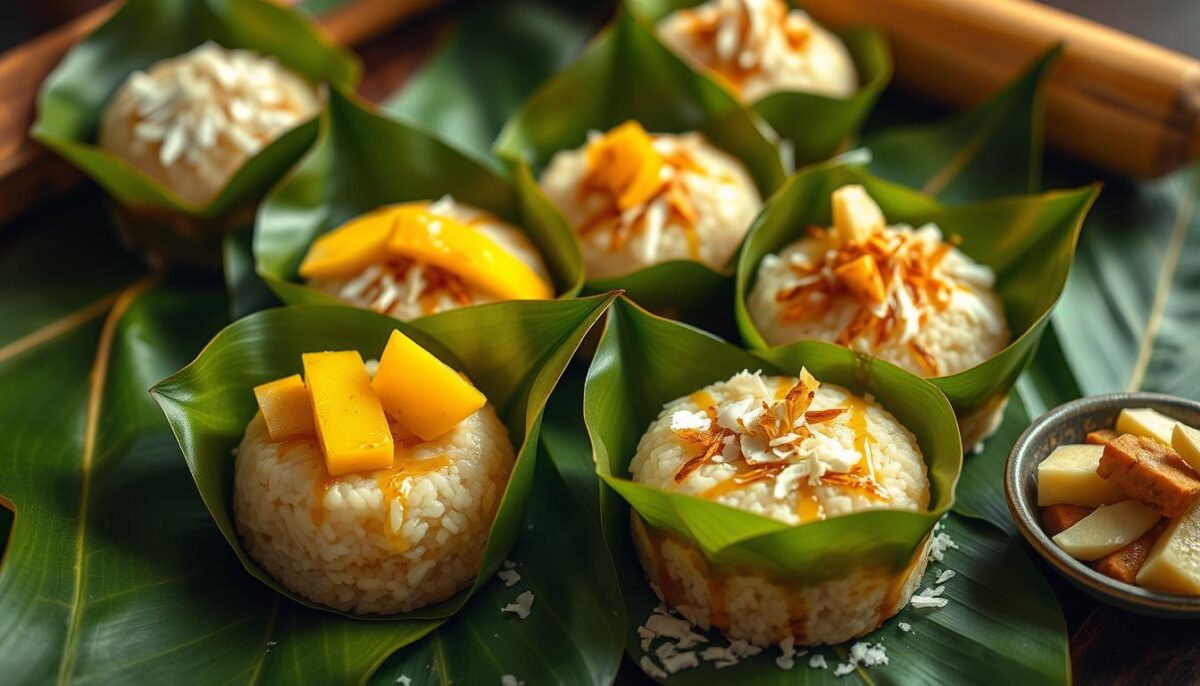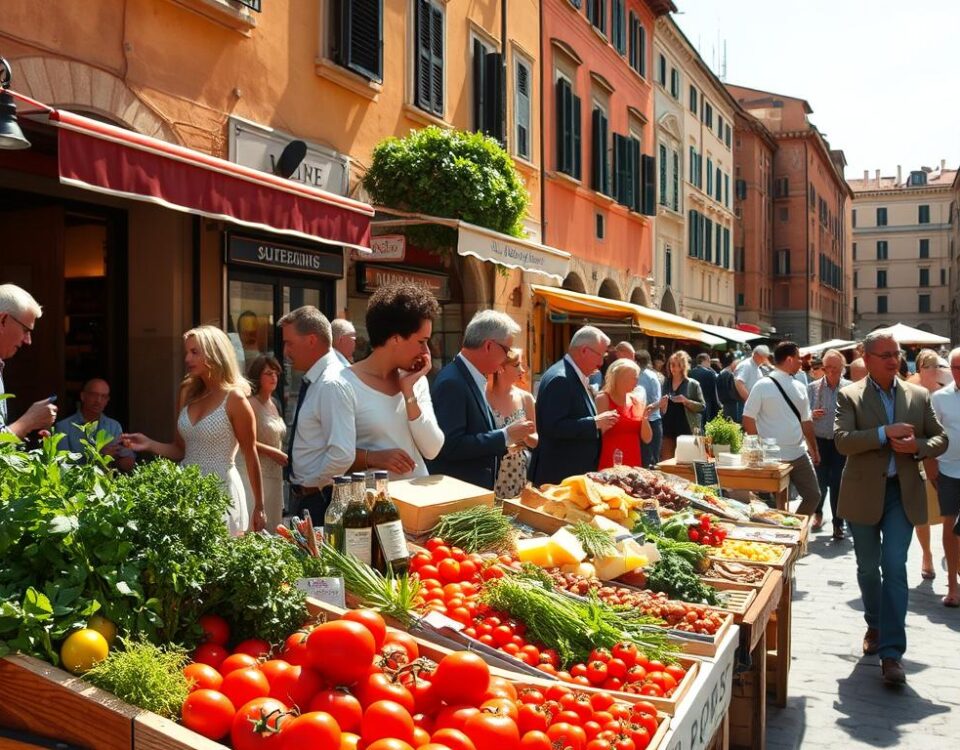
How to Taste the Soul of Paris in Just One Day
June 5, 2025
What to Order in New York if You Want to Eat Like a Local
June 5, 2025Did you know Thailand’s capital has over 20,000 street food stalls? That’s more than the number of convenience stores in New York City. My first time wandering through a buzzing night market here, I stumbled upon a tiny stall with a line stretching halfway down the block. The owner handed me a steaming plate of pad see ew—stir-fried noodles glazed in smoky soy sauce—and I instantly understood why locals and travelers alike obsess over this city’s flavors.
From crispy pork belly at unmarked alleyway carts to fragrant curries served in family-run shops, every bite tells a story. I’ve spent years exploring these vibrant streets, chasing recommendations from taxi drivers and grandmothers alike. What makes the culinary scene here special isn’t just the variety—it’s the passion behind every dish.
This guide isn’t about fancy menus or Instagram traps. It’s about authentic experiences you’ll remember long after your flight home. Whether you’re a first-time visitor or a seasoned traveler, these seven dishes unlock the heart of the city’s culture—one unforgettable taste at a time.
Key Takeaways
- Discover hidden street vendors and family-run eateries loved by residents
- Explore a mix of sweet, spicy, and savory flavors unique to the region
- Learn how to navigate bustling markets and order like a pro
- Find budget-friendly options that cost less than a coffee back home
- Get insider tips on avoiding tourist traps while staying safe
Introduction to Bangkok’s Culinary Scene
My spoon froze mid-air when I first tasted tom yum from a rickety cart near Chinatown. Steam rose like a flavor geyser—lemongrass tang, chili heat, and lime zest dancing together. That moment taught me why authentic meals matter more than any museum visit.
Why Every Bite Tells a Story
I chase dishes where recipes outlive their creators. One cook told me, “This curry paste? My grandmother’s hands mixed it first.” That connection transforms meals into time capsules. You’re not just eating—you’re preserving heritage.
“Thai cuisine isn’t about perfection. It’s about the sweat, stories, and generations in every wok toss.”
From Palaces to Pavements
Royal kitchens once blended Chinese spices with Malay techniques. Today, that legacy thrives in sizzling woks across the city. Check how history shaped today’s favorites:
| Era | Influence | Modern Dish |
|---|---|---|
| Ayutthaya | Portuguese traders | Massaman curry |
| Rattanakosin | Chinese immigrants | Kuay teow noodles |
| 20th Century | Globalization | Pad kra pao basil stir-fry |
Night markets became community hubs after WWII. Vendors rebuilt lives through shared meals—a tradition that still fuels the city’s heartbeat. Now, let’s explore where these flavors shine brightest.
Exploring the Vibrant Bangkok Street
The rhythmic clang of a metal spatula against a well-seasoned wok greets you before your eyes adjust to the scene. Neon signs flicker above narrow walkways where steam rises like edible fog. This isn’t just commerce—it’s theater, with vendors as performers and sizzling oils as their soundtrack.
Hidden Markets and Bustling Alleys
I once followed the scent of caramelized palm sugar down an alley barely wider than my shoulders. Behind a curtain of hanging laundry, a family-run stall served coconut pancakes so delicate they dissolved like sweet whispers. These moments make exploration priceless.
Yaowarat Road’s glow after sunset reveals a different energy. Elderly cooks fry mussel omelets beside teens crafting rainbow-colored shaved ice. The diversity astounds—one cart might specialize solely in grilled banana blossoms, while its neighbor perfects 20-year-old pork broth recipes.
Pro tip: Carry small bills and watch where locals cluster. Arrive early for crispy-skinned duck or late for smoky squid skewers. Avoid umbrella-toting crowds at lunch rush—patience rewards with shorter lines.
Chatting with a woman frying shallots at 6 AM taught me her secret: “We use day-old rice for texture.” That’s how you discover gems like tamarind-glazed chicken wings or emerald-green pandan dumplings—dishes that never make travel blogs but define real culinary adventures.
Bangkok local food musts: Iconic Dishes
I nearly dropped my chopsticks when a vendor handed me boat noodles—a bowl so rich with cinnamon and star anise, it tasted like liquid history. This isn’t just soup. It’s a cultural artifact simmered in spices traded along ancient routes.
- Boat noodles: Dark broth infused with pig’s blood and five-spice powder, served with springy rice noodles
- Green papaya salad: Shredded unripe fruit pounded with chilies, lime, and fermented crab—a fiery crunch
- Khao soi: Crispy-curly noodles swimming in coconut curry, crowned with pickled mustard greens
What makes these stand out? It’s the dance between ingredients and technique. Vendors still use mortar-and-pestle pounding to release essential oils from lemongrass—something blenders can’t replicate. I’ve watched cooks stir-fry holy basil until edges crisp like stained glass.
| Dish | Key Ingredients | Unique Twist |
|---|---|---|
| Boat Noodles | Star anise, cinnamon, beef tendon | Broth simmered 8+ hours |
| Green Papaya Salad | Tamarind, peanuts, green beans | Hand-squeezed lime acidity |
| Mango Sticky Rice | Coconut milk, jasmine rice | Salt enhances sweetness |
At Yaowarat Road stalls, I learned why pad kra pao varies: one cook uses minced pork, another opts for squid. “We compete through recipes,” a chef told me, winking as she tossed chilies into smoking oil. That rivalry fuels innovation while honoring roots—the true secret behind these edible icons.
Savoring Thai Street Food: My Personal Experience
Rain-slicked streets reflected neon signs as I bit into a skewer of grilled satay that changed how I view quick meals forever. The smoke from charcoal grills clung to my clothes for days afterward—a delicious souvenir from my trip. Street vendors here don’t just serve dishes; they orchestrate flavor symphonies with decades-old recipes.
One morning near a temple, I stumbled upon a woman frying banana fritters in palm oil. Her hands moved like a card dealer’s—swift, precise, never missing a beat. “Try with sticky rice,” she urged, handing me a banana leaf parcel. The contrast of crispy batter and coconut-scented rice became my daily ritual.
You’ll find surprises in every corner. A cart specializing in khanom krok (coconut pancakes) might sit beside a grandfather simmering duck blood soup. I learned to embrace the chaos—no menus, no English signs, just pointed gestures and shared smiles. My best meal cost less than a subway ticket back home.
Three lessons shaped my adventures:
- Follow sizzling sounds—they lead to golden pork belly crackling
- Eat where plastic stools outnumber tables
- Let vendors choose your dish—they know what’s freshest
Street food became my compass. It taught me neighborhoods through scents—tamarind near schools, lemongrass by ferry docks. Now when I travel, I seek those unscripted moments where flavor and humanity collide. That’s the real magic you can’t Google.
Must-Try Bangkok Rice & Noodle Delicacies
The aroma of charred wok hei hit me before I saw the vendor’s cart—smoky whispers promising comfort in every bite. This city’s true magic lies in humble grains transformed through fire, broth, and generations of know-how.
Boat Noodles and Pad Thai Variations
I once watched a cook stir boat noodles broth for six hours, her ladle scraping the pot’s caramelized edges. The result? A mahogany-colored elixir with depth that made my spoon stand upright. These tiny bowls pack big flavor—star anise, cinnamon, and tender beef shank swimming with rice noodles.
Pad Thai here defies expectations. One version uses tamarind paste for tanginess, another adds crab roe for umami richness. Portions come wrapped in thin egg nets or topped with quail eggs—each stall adds its signature twist.
| Dish | Base Ingredient | Signature Element |
|---|---|---|
| Boat Noodles | Rice noodles | 5-spice bone broth |
| Pad Thai | Stir-fried noodles | Palm sugar caramelization |
| Khao Mun Gai | Jasmine rice | Chicken fat-infused grains |
For rice lovers, don’t miss khao mun gai—steamed chicken atop glistening grains cooked in garlic broth. The best spots? Follow office workers at lunch to unmarked shophouses near BTS stations. Arrive before noon—these treasures sell out fast.
Pro tip: Noodle dishes often come with four seasoning elements—chili flakes, sugar, fish sauce, and vinegar. Mix them boldly. As one vendor told me, “Balance isn’t given—it’s created.”
Exploring Seafood Staples in Bangkok
The hiss of a grill greeted me before I saw the mountain of ice holding ruby-red shrimp at a riverside stall. Here, the ocean’s bounty meets fiery woks and generations of culinary wisdom. Every coastal influence—from Malay spice blends to Chinese steaming techniques—converges in sizzling pans along the Chao Phraya.
Fresh Shrimp, Squid, and Tom Yum Goong
I’ll never forget the first time I tasted tom yum goong made with shrimp caught that dawn. The broth exploded with galangal’s piney kick and kaffir lime’s citrus punch. A cook showed me her secret: “We add coconut milk after boiling chilies—it keeps the heat bright.”
Squid gets star treatment too. Vendors score the flesh into flower patterns before flash-frying—a technique creating crispy edges while keeping centers tender. One stall near IconSiam serves theirs with dipping sauce blending tamarind and palm sugar—sweet, tangy, and utterly addictive.
Street-Side Seafood Stalls You Can’t Miss
Follow the scent of charcoal to find gems like “Jay Fai’s neighbor”—a nameless cart grilling giant river prawns wrapped in banana leaves. Their trick? Brining in lemongrass-infused seawater for 24 hours. For squid lovers, the unmarked stall behind Wat Arun fries rings so light they dissolve like savory cotton candy.
| Dish | Key Feature | Best Spot |
|---|---|---|
| Grilled Shrimp | Marinated in turmeric | Khlong Lat Mayom |
| Spicy Squid Salad | Fresh mint garnish | Talad Rot Fai |
| Tom Yum Goong | River prawn heads | Chinatown alleys |
Pro tip: Arrive before sunset when boats unload daily catches. Look for stalls using bamboo baskets—they prioritize airflow to keep shellfish fresh. And don’t shy from eating with your hands—the best flavors stick to your fingers.
The Flavor of Thai Pork and Beef Dishes
I still remember the crackle of caramelized palm sugar hitting a searing grill—the sound that announced my introduction to moo ping. These glazed pork skewers, marinated in coconut milk and turmeric, taught me how Thai cooks turn simple cuts into smoky-sweet masterpieces. From street carts to decades-old shophouses, meat here isn’t just protein—it’s a canvas for balancing sweet, salty, and umami.
Grilled Pork Skewers and Roast Pork Perfection
Watch any vendor’s hands at dawn—they’re threading pork neck onto bamboo sticks with military precision. The magic lies in the marinade: fish sauce for saltiness, cilantro roots for earthiness, and a hint of mageu (fermented rice) for tang. Roast pork takes it further. One Chinatown spot slow-cooks belly for hours until the fat renders into golden lace.
Beef Noodle Wonders in the City
Beef shines in broths simmered with cinnamon sticks and star anise. At a stall near Wongwian Yai, I tried kuay chap—wide rice noodles swimming in dark, herbal soup with melt-off-the-bone shank. The owner shared his secret: “We use three cuts—shank for texture, tendon for silkiness, marrow for richness.”
| Dish | Key Technique | Flavor Profile |
|---|---|---|
| Moo Ping | Charcoal grilling | Smoky-sweet |
| Kuay Chap | 12-hour broth simmer | Herbal-umami |
| Khao Kha Moo | Braised pork leg | Garlic-soy |
What makes these dishes unforgettable? It’s the respect for every cut—nothing wasted, everything enhanced. As one cook told me while basting skewers, “Good meat speaks for itself. We just listen.”
Adventurous Eats: Innovative Street Creations
I once tasted a green curry croissant that made me question everything I knew about flavor boundaries. Chefs here aren’t just cooking—they’re rewriting culinary rules with each sizzling wok toss. Traditional recipes get remixed into bold new versions that surprise even seasoned travelers.
Fusion Dishes and Modern Twists
Imagine tom yum soup reimagined as crispy spring rolls, or mango sticky rice transformed into mochi balls. These creations honor heritage while embracing global influences. One vendor told me, “We use grandmother’s curry paste but pair it with ingredients she never saw—like truffle oil or matcha powder.”
Three trends redefine street eats today:
- Deconstructed classics: Pad Thai served as bite-sized tacos
- Unexpected textures: Crunchy fried basil in coconut ice cream
- Cross-cultural mashups: Massaman curry dumplings
| Traditional Dish | Modern Version | Key Twist |
|---|---|---|
| Massaman Curry | Massaman Tacos | Turmeric tortillas |
| Som Tum Salad | Som Tum Sorbet | Chili-lime granita |
| Khao Soi | Khao Soi Ramen | Miso-infused broth |
“Innovation isn’t about replacing tradition—it’s adding new chapters to the story.”
These dishes prove flavor experimentation thrives here. Vendors balance familiar pastes with daring ingredients—think lemongrass-infused chocolate or shrimp paste caramel drizzle. The best part? You’ll find these creations at unmarked carts beside century-old temples.
Pro tip: Seek stalls with handwritten signs listing “special edition” dishes. Ask for recommendations—chefs love sharing their latest experiments. Remember, every bold bite keeps this culinary culture alive and evolving.
Delicious Thai Desserts and Sweet Treats
My fingers still remember the warm cling of sticky rice as I shaped my first mango dessert parcel. Thai sweets don’t just satisfy cravings—they turn textures into art forms. From jiggly coconut custards to flower-shaped dumplings, each bite celebrates centuries of culinary craft.

Mango Sticky Rice and Other Local Sweets
The magic of mango sticky rice lies in contrasts: cool fruit against warm grains, creamy coconut sauce cutting through earthy sweetness. Vendors use glutinous rice soaked overnight, then steamed with pandan leaves for floral depth. Pro tip: Salt sprinkled on top isn’t a mistake—it amplifies the mango’s natural sugars.
Coconut stars in many treats. Try kanom krok—crispy-edged pancakes with molten coconut centers. Or tub tim grob, where ruby water chestnuts bob in icy coconut milk. One vendor told me, “We use three coconut parts: milk for richness, cream for silkiness, shavings for crunch.”
| Dish | Key Ingredients | Twist |
|---|---|---|
| Mango Sticky Rice | Glutinous rice, coconut milk | Black sesame drizzle |
| Kanom Chan | Coconut, pandan, rice flour | 9-layer rainbow stack |
| Bua Loy | Coconut milk, colored rice balls | Ginger-infused syrup |
Modern stalls now riff on classics. I’ve tried sticky rice cheesecake and coconut ice cream rolled in tempura crumbs. For traditionalists, seek vendors near temples using clay pots to steam rice—their methods haven’t changed since the 1920s.
Craving more? Explore exotic Asian sweets that pair perfectly with Thai tea. My favorite spots? Look for carts with handwritten menus and lines of regulars—they’re keepers of the sweetest secrets.
Balancing Sweet and Savory: Thai Sauces & Condiments
A vendor once handed me a tiny bowl of amber liquid that transformed grilled chicken into fireworks of flavor. Thai sauces aren’t just toppings—they’re alchemists turning simple bites into symphonies. From tangy tamarind dips to garlic-laced chili pastes, these elixirs define the country’s culinary soul.
What makes these blends magical? It’s the dance between extremes. A single sauce might balance palm sugar’s sweetness with fish sauce’s saltiness, then spike it with lime acidity. Garlic often anchors these mixes, its pungent warmth softening chili heat. I’ve watched cooks roast cloves until caramelized, then pound them with shrimp paste—a base for iconic dips like nam prik pao.
Three essentials rule street stalls:
| Sauce | Key Ingredients | Best Paired With |
|---|---|---|
| Nam Pla Prik | Fish sauce, bird’s eye chili, garlic | Grilled meats, omelets |
| Prik Nam Som | Vinegar, sugar, sliced chilies | Fried snacks, soups |
| Satay Sauce | Peanuts, coconut milk, turmeric | Skewers, fresh veggies |
Chefs wield these like artists. “Sauce isn’t an afterthought,” one explained while stirring a vat of peanut curry. “It’s the bridge between fire and comfort.” At home, try layering flavors: start with salty, add sweet, finish with citrus zing. Keep small bowls of contrasting dips—the interplay creates new dimensions in every bite.
Pro tip: Always taste sauces alone first. Their intensity shifts when paired with dishes. And don’t fear experimentation—mixing chili jam with sour mango creates addictive tanginess. As street vendors prove daily, the right condiment turns meals into memories.
Insider Tips for Eating Like a Local
Timing is everything when the city’s flavors come alive at dusk. I learned this after arriving too early at a famed market—stalls were still unpacking herbs and sharpening cleavers. Returned an hour later, and the air buzzed with sizzling woks and seasoned regulars.
Navigating Night Markets and Timing Your Visits
Peak hours vary by location. Busiest spots hit their stride between 7-9 PM, while hidden alleys serve late-night crowds until 2 AM. Watch for “second wave” vendors—they replace lunch-focused carts after sunset with fresher, bolder options.
| Market Type | Best Time | Pro Strategy |
|---|---|---|
| Tourist Hotspots | 6:30-7:30 PM | Arrive as stalls open for first batches |
| Residential Areas | 8-10 PM | Follow office workers leaving BTS stations |
| 24-Hour Zones | Midnight-2 AM | Seek taxi driver hangouts for post-shift specials |
Staying Safe and Embracing the Experience
Three rules keep adventures enjoyable:
- Follow the steam: Active grills mean high turnover—key for seafood and meats
- Carry hand sanitizer: Many spots lack running water
- Learn four phrases: “Ped nit noi” (less spicy) and “Ao kin tee nee” (I’ll eat here) build rapport
I once avoided a stomach issue by choosing stalls where cooks wore gloves and used tongs. Notice details—clean oil, covered ingredients, and cash handled separately from food. The city rewards those who balance curiosity with caution.
Cultural Insights Behind Bangkok’s Culinary Traditions
Standing under a century-old banyan tree, I watched a vendor fold banana leaves around sticky rice—a technique unchanged since her great-grandmother’s time. This city’s flavors aren’t just meals; they’re edible archives preserving stories of migration, trade, and resilience.
Traditional Influences and Modern Adaptations
Every dish here whispers history. Chinese immigrants introduced wok techniques, while Indian traders brought cumin-infused curries. Portuguese explorers left their mark with chili peppers—now Thailand’s fiery signature. Today, cooks balance these roots with today’s tastes. I once tried pad Thai dusted with edible gold—a playful nod to royal cuisine now served in alleyways.
Three ways tradition meets innovation:
- Mortar & pestle meets machine: Some stalls grind curry paste by hand; others use blenders but add hand-pounded herbs
- Global ingredients, local soul: A chef told me, “We swap tamarind for balsamic glaze—but keep palm sugar’s caramel depth”
- Street food fine-dining: Crispy pork belly appears in Michelin-starred tasting menus
| Traditional Dish | Modern Twist | Cultural Bridge |
|---|---|---|
| Khao Soi Curry | Deconstructed broth shots | Lanna heritage meets molecular gastronomy |
| Mango Sticky Rice | Ice cream roll version | Royal dessert reimagined for fast-paced crowds |
| Tom Yum Soup | Carbonated infusion | War-era comfort food becomes cocktail mixer |
“We don’t own these recipes—we borrow them from ancestors and lend them to the future.”
My deepest meals happened when vendors shared stories behind spices. Knowing that turmeric in my curry once dyed monks’ robes added layers no menu could describe. These connections turn snacks into time travel—one bite linking Sukhothai artisans to today’s midnight fry cooks.
Next time you taste chili-lime fish sauce, remember: you’re savoring centuries of adaptation. That’s the real magic hiding in every steamy alley wok.
Discovering Top Thai Restaurants and Shophouses
Dawn light filtered through steamed windows as I pressed my nose against a 90-year-old shophouse’s glass. Inside, a chef meticulously arranged crab meat into flower patterns atop curry puffs—a morning ritual unchanged since his grandfather’s era. These culinary sanctuaries blend heritage with innovation, offering tastes that define Thailand’s dining soul.
Local Gems and Established Institutions
One day, I stumbled upon a narrow alleyway eatery where handwritten menus change hourly. Their signature dish? Chicken rubbed with lemongrass ash, smoked over coconut husks. “We butcher birds at 4 AM,” the owner shared, pointing to dawn deliveries. Heritage spots like these prioritize craft over speed—you taste the difference in every bite.
For seafood lovers, a riverside institution serves crab curry in clay pots sealed with banana leaves. Their recipe survived three generations by balancing chili heat with palm sugar sweetness. Modern twists exist too: a hip Sukhumvit spot stuffs crispy rice balls with salted egg yolk, served alongside smoked fish dip.
| Venue | Specialty | Pro Tip |
|---|---|---|
| Heritage Shophouse | Crab curry puffs | Arrive before 11 AM |
| Modern Eatery | Chicken ash-rubbed skewers | Weekday lunches avoid crowds |
| Riverside Icon | Clay pot seafood | Request riverside seating |
Timing matters. Visit shophouses early—dishes sell out by 2 PM. For dinner spots, book tables three days ahead during peak seasons. One chef advised: “Come Tuesday-Thursday. We experiment with new recipes when it’s quieter.”
“Great meals hide where walls whisper stories. Follow the cracks in the pavement—they lead to treasures.”
Navigating Bangkok’s Best Food Markets
Golden hour transforms market alleys into flavor tunnels—each turn revealing sizzling woks, rainbow-colored sweets, and vendors shouting over clattering pans. I once followed a trail of roasted coconut smoke to a stall wrapping banana leaf parcels, realizing markets here aren’t just shopping spots. They’re living museums of taste.
From Street Stalls to Vibrant Night Markets
Chatuchak’s maze-like corridors teach patience. Stalls specialize in single dishes: one sells only tamarind-glazed fish, another crafts emerald-green pandan dumplings. For quality, visit Or Tor Kor at dawn—farmers arrange dragon fruits like jewels while butchers carve heritage-breed pork.
Three ways to master market exploration:
- Follow ingredient trails: Look for stacked coconut milk cans or baskets of kaffir lime leaves
- Time your visits: Arrive early for crispy pork belly, late for smoky squid skewers
- Engage tactfully: Point at what locals order and say “Same, please” with a smile
At Talad Rot Fai, I discovered a stall frying shallot-crusted quail eggs beside vintage motorcycles. The owner shared his secret: “We use duck fat from the farm up north.” These unexpected finds make wandering worthwhile.
| Market | Specialty | Best Time |
|---|---|---|
| Khlong Toei | Fresh herbs & spices | 6-8 AM |
| Wang Lang | Grilled banana blossoms | 3-5 PM |
| Jodd Fairs | Volcano pork skewers | 7-10 PM |
Pro tip: Carry hand sanitizer and small bills. Watch where cooks eat—their go-to stalls often hide behind unmarked curtains. Markets here reward curiosity, turning every wrong turn into a delicious detour.
Planning Your Ultimate Bangkok Food Adventure
The clatter of a metal spoon against a steaming pot snapped me to attention—my signal to start mapping today’s flavor hunt. Crafting the perfect food itinerary here requires equal parts strategy and spontaneity. Let me share how I balance fiery chili kicks with silky soup bowls while dodging tourist traps.

First, divide your days by neighborhood. Hit Yaowarat’s spice alleys at dusk for knockout tom yum, then explore Old Town’s hidden shophouses at dawn. Always carry:
- A reusable container for leftovers (trust me)
- Hand sanitizer and tissues
- Google Maps pinned with street vendor clusters
For soup lovers, mark stalls simmering bone broth overnight. Look for cauldrons with floating shallots—they signal depth. Craving heat? Seek out chili-crusted squid salads near universities where students demand authentic fire.
| Time Slot | Focus | Budget Tip |
|---|---|---|
| 7-9 AM | Steamed rice dishes | Follow office workers |
| 12-2 PM | Noodle carts | Share portions to sample more |
| 6-8 PM | Grilled seafood | Bargain politely after 7:30 PM |
I save 30% on transport using river ferries and rabbit cards for BTS trains. Pro tip: Book a hotel near a night market—you’ll stumble upon midnight mango sticky rice runs. One vendor told me, “Eat with the sun. Rise early, rest at noon, feast under stars.”
Leave gaps for serendipity. That unmarked stall frying banana fritters? Worth reshuffling plans. Remember, the best meals aren’t found—they find you when you’re deliciously lost.
Conclusion
Every bite I’ve savored here feels like uncovering hidden treasure—each dish a map to stories older than the streets themselves. Through smoky grills and steaming pots, I’ve learned that tasting a city means embracing its heartbeat.
What makes this place extraordinary isn’t just the lot of flavors available. It’s how generations pour passion into every little thing—from mortar-pounded herbs to charcoal-scorched woks. Those details transform meals into memories.
Don’t just visit the places I’ve shared—chase your own discoveries. Let curiosity guide you to carts where laughter spills louder than broth. Pack patience, small bills, and an appetite for the unexpected.
My advice? Start planning now. Book that flight, lace comfortable shoes, and arrive hungry. The real magic happens when you trade menus for moments—one unforgettable taste at a time.
FAQ
What’s the best way to try street eats safely?
I stick to stalls with high turnover or crowds—freshness is key. Carry hand sanitizer, avoid raw veggies if unsure, and opt for cooked dishes like grilled pork skewers or piping-hot boat noodles. Vendors like Jay Fai (a Michelin-starred spot) are legendary for quality.
Which dishes define the city’s flavor identity?
You can’t leave without tasting pad Thai with tamarind sauce, tom yum goong (spicy shrimp soup), and mango sticky rice. For something bold, try kuay teow neua (beef noodle soup) or moo ping (grilled pork) with sticky rice—it’s pure comfort.
Where do locals go for authentic eats?
Chinatown’s Yaowarat Road has iconic spots like T&K Seafood. Hidden alleys near Chatuchak Market or shophouses in Bang Rak also serve classics like khao man gai (chicken rice) and crab omelets. Follow the sizzle and smoke—it’s usually worth it.
How do I handle spicy condiments?
Start small! Thai chili paste (nam prik) and fish sauce dips pack heat. Mix a little into your dish first. If it’s too much, coconut milk-based curries or sweet treats like roti gluay (banana pancake) balance the burn.
Are there vegetarian-friendly options?
Absolutely! Look for “jay” (vegetarian) signs or request “mai sai naam pla” (no fish sauce). Dishes like pad pak boong (stir-fried morning glory) or tofu-filled green curry are common. Night markets often have vegan mango sticky rice, too.
What’s unique about seafood here?
Freshness rules. Try pla pao (salt-crusted grilled fish) or hoy tod (crispy oyster omelet). Squid rings with garlic-chili dip are a must. Head to Lek & Rut Seafood near Sukhumvit—their garlic-pepper squid is life-changing.
How do I navigate night markets efficiently?
Go early to beat crowds, carry small bills, and split dishes to try more. Rot Fai Market’s vintage vibe and Talad Neon’s neon lights are perfect for grazing. Don’t miss grilled river prawns or coconut ice cream!



